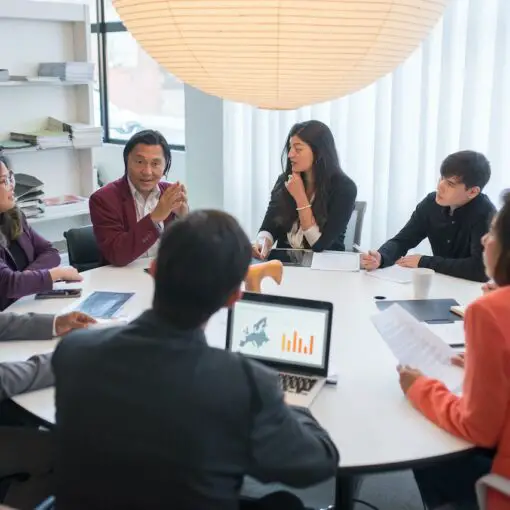Strategic thinking and analytical thinking are two essential skills in the business world. Both play crucial roles in decision-making processes, but they differ in approach and application. Understanding the differences between these two thinking styles can help organizations make informed choices and drive success.
Strategic thinking is a forward-looking process that involves considering the big picture, anticipating future challenges, and developing long-term plans. This type of thinking enables individuals to connect the dots, identify opportunities, and create a clear vision for the organization. On the other hand, analytical thinking is a problem-solving mindset, focusing on breaking down information, examining data, and identifying patterns to solve immediate issues.
While both thinking styles have their place in an organization, it’s essential for individuals to know when to employ each one and how to combine them effectively. By understanding and honing these skills, professionals can make better decisions, drive innovation, and contribute to an organization’s overall success.
Strategic Thinking vs Analytical Thinking
Divergent and Convergent Thinking
Strategic thinking and analytical thinking are two different approaches to problem-solving and decision-making. They can be connected to the concepts of divergent thinking and convergent thinking, respectively.
Divergent thinking, often linked to strategic thinking, focuses on generating multiple solutions to a problem, exploring various possibilities, seeking innovative ideas, and identifying potential opportunities ^. This type of thinking aims to expand the range of options and is considered more creative and open-minded.
On the other hand, convergent thinking, associated with analytical thinking, is a more systematic approach where individuals evaluate, analyze, and narrow down the available options to reach the best solution or decision ^. This type of thinking is linear, logical, and detail-oriented.
Innovation and Control
Both strategic thinking and analytical thinking are essential for organizations and individuals. However, they serve different purposes and have different characteristics.
Strategic thinking is proactive, agile, and focused on long-term success ^. It encourages innovation and creativity and involves exploring “what if” scenarios and anticipating future trends. Strategic thinking helps to identify new ways of achieving goals, plan for unforeseen circumstances, and adapt to change.
In contrast, analytical thinking is more concerned with control and maintaining stability. It includes examining data, evaluating evidence, and organizing information to identify patterns and understand complex situations. Analytical thinking allows individuals to make informed decisions and stay aligned with the organization’s objectives.
In summary,
- Strategic thinking (divergent thinking) involves generating multiple solutions and exploring various possibilities.
- Analytical thinking (convergent thinking) is a systematic approach to evaluating and narrowing down options.
- Strategic thinking focuses on innovation, while analytical thinking emphasizes control.
Having a balance between strategic and analytical thinking is crucial for success in today’s dynamic and competitive environment. Both approaches complement one another and can be harnessed for effective problem-solving and decision-making.
Key Components of Strategic Thinking
Strategic thinking is essential in helping individuals and organizations navigate complex issues and effectively plan for the future. It involves anticipating future needs, identifying opportunities, and making decisions that align with long-term goals. This section will discuss some of the core components of strategic thinking, including vision and future focus, problem-solving, and communication.
Vision and Future Focus
Strategic thinkers are known for their strong vision and focus on the future. They have the ability to imagine how current trends and events may impact their organization in the long run, and plan accordingly. This involves strategic foresight which allows them to anticipate potential problems and have backup plans in place. Being intent-focused, they keep their overarching goals and direction in mind while remaining adaptable to ever-changing circumstances. They are curious, never hesitating to question conventional thinking and are constantly looking for new ways to contribute to their organization’s success.
Problem-Solving
Problem-solving is another crucial aspect of strategic thinking. Strategic thinkers analyze situations from multiple perspectives, gathering and synthesizing information to make informed decisions. They are also able to break down complex problems into manageable parts, identifying key issues and developing creative and effective solutions. Constantly scanning for new information and adjusting their approach when needed, strategic thinkers maintain an open mind and are willing to learn from mistakes.
Communication
Effective communication is essential for strategic thinkers, as it enables them to share their ideas, align their team around common goals, and foster a culture of collaboration and innovation. This involves not only clearly articulating their thoughts and plans but also actively listening to others and incorporating feedback. By creating an environment where open and transparent dialogue is encouraged, strategic thinkers can more easily foster a shared understanding of the organization’s direction, inviting employees at all levels to contribute to the overall success.
In summary, strategic thinking involves vision, problem-solving, and communication skills that empower individuals and organizations to plan for the future, navigate complex challenges, and achieve long-term success. By developing these skills, individuals can make more informed decisions, better adapt to changing circumstances, and contribute to their organization’s ongoing growth.
Key Components of Analytical Thinking
Data Analysis and Insight
Analytical thinking involves the process of breaking complex problems or systems into smaller parts to understand how they work. One significant component of analytical thinking is data analysis and insight. Data analysis involves evaluating data to detect patterns, make inferences, and draw conclusions. Some key aspects of data analysis include:
- Gathering relevant data from various sources
- Organizing data in a structured manner
- Identifying patterns, trends, and correlations within data
- Interpreting the results and generating insights
Analytical thinkers use these insights to make well-informed decisions and solve problems effectively.
Critical Thinking
Another critical aspect of analytical thinking is critical thinking. It is the ability to think clearly and rationally, understanding the logical connection between ideas. It involves evaluating information objectively and making a judgment based on evidence. Some key elements of critical thinking include:
- Identifying assumptions and biases in the presented information
- Evaluating the quality and credibility of evidence
- Assessing the strength of arguments and conclusions
- Considering alternative viewpoints and perspectives
Developing strong critical thinking skills can help individuals effectively analyze situations and develop creative solutions.
Decision Making
The final component of analytical thinking is decision making. Analytical thinkers use data analysis and critical thinking to make decisions that are logical, rational, and informed by evidence. The decision-making process generally involves the following steps:
- Identifying the problem or decision to be made
- Gathering relevant information and analyzing data
- Generating possible solutions or alternatives
- Evaluating the pros and cons of each option
- Choosing the best option and implementing it
- Monitoring and reviewing the results of the decision
By consistently applying analytical skills in the decision-making process, individuals can boost their ability to make effective decisions and improve their professional and personal lives.
Developing Strategic and Analytical Thinking
Leadership and Employee Development
Developing both strategic and analytical thinking is essential to career advancement for both employees and leaders within an organization. Strategic thinking involves the ability to think ahead and anticipate potential problems, while also being proactive in spotting opportunities for growth. On the other hand, analytical thinking focuses on breaking down complex problems into smaller, more manageable parts to find solutions.
To foster strategic thinking skills, employers can encourage staff members to ask strategic questions. This practice promotes planning, problem-solving, and the development of a more strategic mindset that can be leveraged throughout one’s career.
Effective leadership also plays a crucial role in developing strategic and analytical thinking. Leaders should create an environment where employees feel comfortable questioning conventional thinking and exploring new ideas. This can be achieved by offering training opportunities, providing regular feedback, and promoting collaboration among team members.
Nurturing Proactive Habits
Being proactive is an essential component of strategic and analytical thinking. Employees should be encouraged to adopt habits that help them think ahead and prepare for potential challenges. Some proactive habits to nurture include:
- Setting clear goals: Define short-term and long-term objectives, both for individual performance and team outcomes. Goals should be specific, measurable, achievable, relevant, and time-bound (SMART).
- Staying informed: Strategic thinkers stay current on industry trends, emerging technologies, and competitor developments. Encouraging employees to read, engage in professional networks, and attend conferences can help them stay informed and better prepared for change.
- Experimenting and learning: Encourage employees to test new ideas and learn from both successes and failures. This fosters a culture of continuous improvement and innovation, which can contribute to strategic growth.
- Taking calculated risks: Cultivate a mindset of risk-taking, where both leaders and employees are willing to make bold decisions based on thorough analysis and a well-thought-out strategy.
By investing in leadership and employee development and nurturing proactive habits, organizations can create a workforce skilled in strategic and analytical thinking, driving better decision-making and stronger performance for the organization as a whole.
Striking the Balance
When it comes to strategic thinking and analytical thinking, striking a balance between the two is crucial for professional success. This section will delve into how effective communication and decision making, as well as synthesis and competitive advantage, are essential to accomplish this balance.
Effective Communication and Decision Making
Effective communication is vital in both strategic and analytical thinking. Strategic thinkers need to articulate their vision, goals, and plans clearly, while analytical thinkers are responsible for presenting data and findings in a manner that is understandable and actionable for everyone. By ensuring that each individual can communicate efficiently with others, organizations can capitalize on the unique strengths that each thinking style offers.
Decision making is another critical aspect to consider when striking the balance between strategic and analytical thinking. Strategic thinkers are responsible for making decisions that shape an organization’s direction and future, while analytical thinkers help analyze data to support and inform those decisions. It’s important for individuals in both roles to collaborate and draw on each other’s strengths to make the best possible decisions for the success of the organization.
Synthesis and Competitive Advantage
A major benefit of striking the balance between strategic and analytical thinking is the ability to synthesize information effectively. Strategic thinking requires participants to question conventional approaches and anticipate potential problems. On the other hand, analytical thinking is a more linear and focused process that involves breaking down complex information into manageable parts. By combining these two ways of thinking, individuals can become better at identifying trends, patterns, opportunities, and risks, ultimately leading to more informed decisions.
Having a balance of strategic and analytical thinking within an organization can also lead to a competitive advantage. Strategic thinking helps with developing overall business strategies and long-term goals, while analytical thinking allows for the monitoring of metrics and achievement of short-term goals. Together, these two types of thinking create a strong foundation for growth and success in any industry.
In conclusion, striking the balance between strategic thinking and analytical thinking is essential for effective communication, decision making, synthesis of information, and ultimately, gaining a competitive advantage. By acknowledging and valuing the unique strengths that each thinking style offers, professionals and organizations alike can maximize their effectiveness and stay ahead in today’s competitive landscape.
Industry Perspectives and Challenges
Strategic Planning and Adaptation
Industry challenges demand a clear and effective strategy planning approach. Strategic thinking involves the ability to see the big picture and make connections to create a path towards organizational success. On the other hand, analytical thinking focuses on breaking down complex problems into smaller, more manageable components to find a solution.
Strategic planning plays a vital role in addressing industry challenges and staying adaptable to rapidly changing conditions. Companies should constantly reassess their goals, strategies, and resources to ensure they remain competitive and relevant. This iterative process helps to align the organization’s direction and fosters a culture that encourages innovation and forward thinking.
Some key aspects of strategic planning and adaptation include:
- Scenario planning and forecasting to anticipate market shifts
- Aligning resources and capabilities to meet long-term goals
- Agility in decision-making and course correction when necessary
Innovation and Industry Trends
Navigating the complexities of an ever-evolving industry landscape is a vital competency for organizations. Understanding the implications of innovation and industry trends helps inform strategic decision-making and fosters an environment that is more responsive to change.
Some common innovation trends that impact industries include:
- Technological advancements, such as AI, automation, and digital transformation
- Evolving customer preferences and behaviors
- New business models and market disruptions
Staying ahead of these trends enables organizations to:
- Identify and capitalize on emerging opportunities
- Develop innovative solutions to existing challenges
- Create a sustainable competitive advantage for the long term
In summary, integrating strategic thinking and analytical abilities through an ongoing focus on the challenges and opportunities inherent in industry dynamics is crucial for thriving in today’s fast-paced business environment. Incorporating strategic planning and an innovative mindset supports the development of effective strategies to navigate complex industry landscapes and overcome potential hurdles.
Consequences of Imbalance
Reactive vs Proactive Approaches
Imbalance between strategic thinking and analytical thinking can lead to an organization taking either a predominantly reactive or proactive approach to problem-solving. When an organization relies heavily on analytical thinking, it tends to be more reactive in its decision-making. This is because analytical thinking focuses on evaluating data and trends after the fact, so responses are often directed towards solving problems that have already occurred. In contrast, strategic thinking emphasizes anticipating future challenges and opportunities, allowing organizations to be more proactive in their approach.
A predominantly reactive approach can prevent an organization from anticipating and preparing for potential issues that may arise in the future. This can leave the organization surprised and unprepared when facing challenges, limiting their ability to respond effectively. Proactive approaches, on the other hand, enable organizations to have a strategic vision and plan for the future, allowing them to adapt and respond in a more controlled and efficient manner.
Strategic Thinking vs Analytical Thinking – Impact on Organizational Success
Balancing strategic thinking and analytical thinking is critical to an organization’s success, as an imbalance can have various consequences. One impact of an imbalance is losing control over the direction of the organization. When there’s too much focus on analytical thinking, an organization may find itself constantly reacting to short-term issues without developing a long-term vision or plan.
Another consequence of imbalance can be the limited innovation within the organization. A constant focus on reacting to current challenges and data, as seen in an analytical thinking-driven approach, might inhibit the ability to think creatively and explore new opportunities – a key aspect of strategic thinking.
To achieve balance, organizations should invest in developing the strategic thinking skills of their employees at all levels, encouraging a culture of continuous learning and curiosity, while also giving equal importance to data and analytics for informed decision-making. This balanced approach ensures that the organization is both prepared for the future and able to respond to unexpected challenges with confidence and flexibility.





